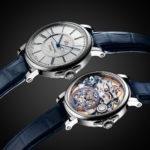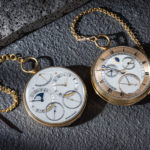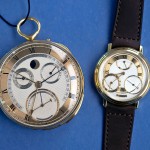In Depth: Marco Lang Zweigesicht-1
Quality that reflects the watchmaker behind it.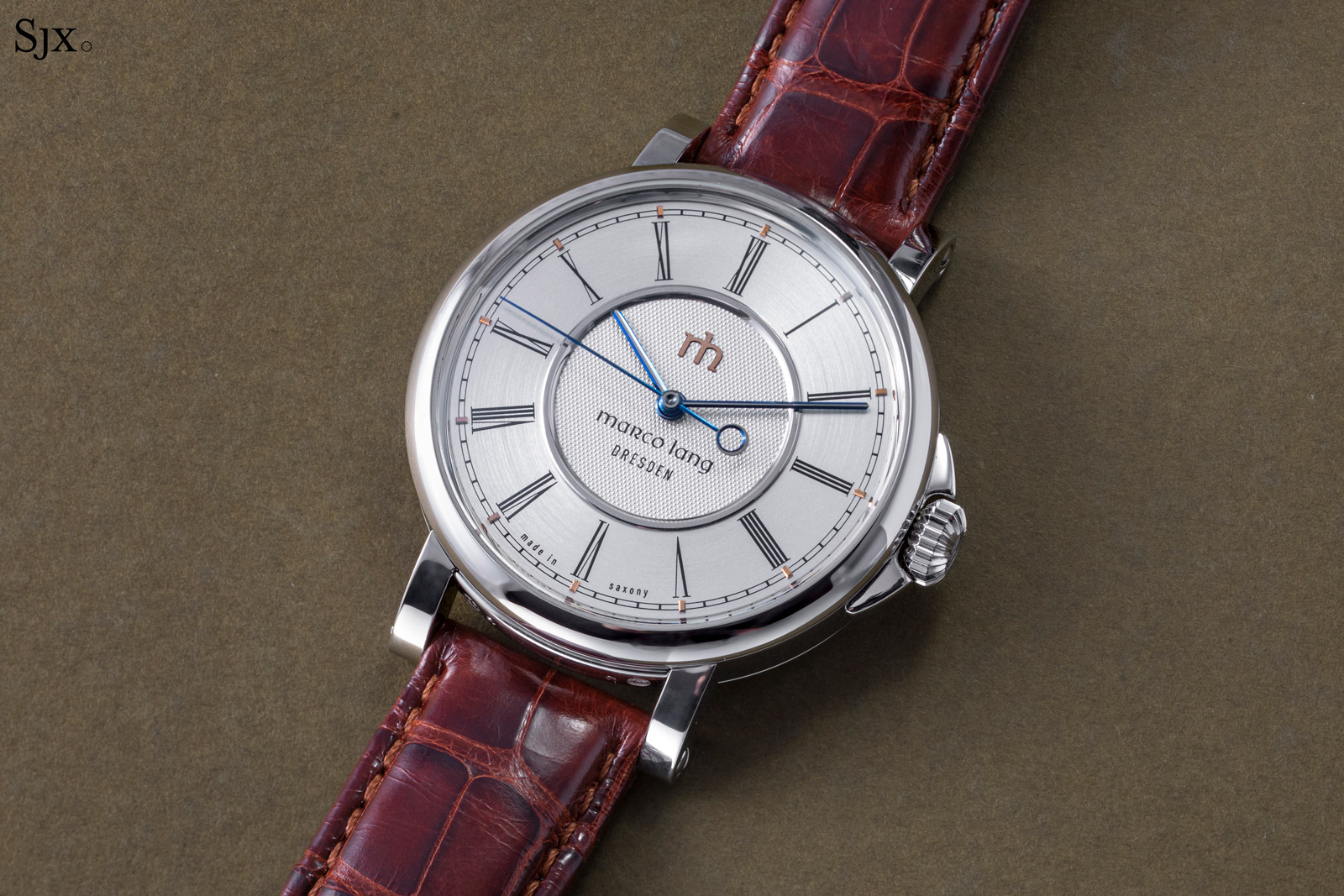
Marco Lang made a comeback in 2020 with his eponymous brand and the Zweigesicht-1. The year before the German watchmaker departed his prior brand after disagreements with the investor who was the majority owner, which allowed Mr Lang to revert to being a true independent watchmaker.
Despite a relatively conservative face, the Zweigesicht is quirky and original from a technical perspective. Zwei gesicht translates as “double faced”, which describes the watch literally. It has two faces, one on each side of the case, both of which indicate the time. The watch can be worn on either side thanks to lugs that are removable (in an operation that requires delicate manual work). And the movement incorporates a novel, and perhaps unnecessary, shock recorder.
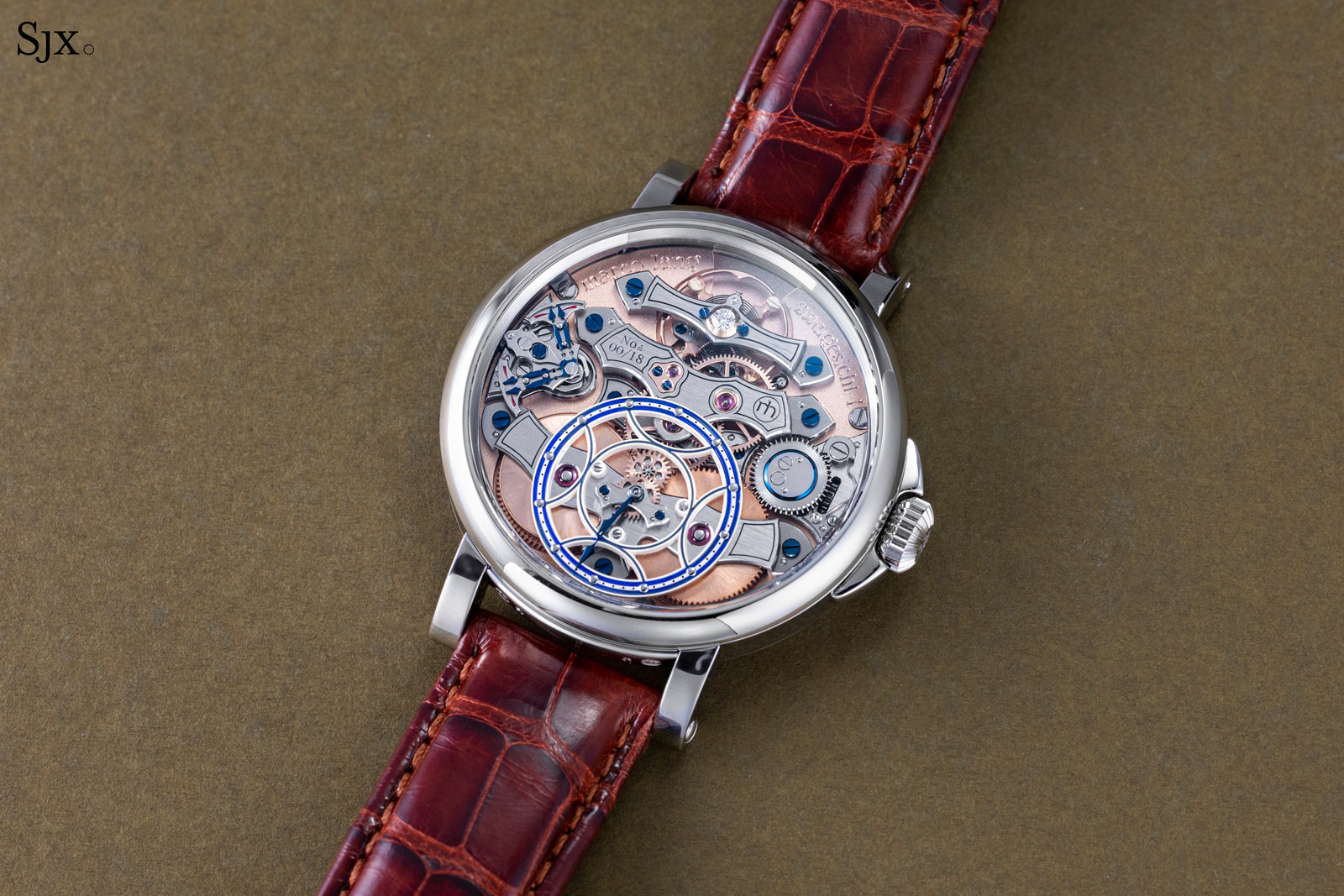
Initial thoughts
To start with, zwei gesicht is a mouthful for non-German speakers. Perhaps for that reason, fellow German watchmaker A. Lange & Söhne opted for made-up words like Zeitwerk and Datograph. But despite the unfamiliar name, the watch is elegant in form, measuring under 10 mm high, and impressive in decoration and construction.
The zwei gesicht nature of the watch gives it two distinct appearances, a low-key conventional front and an elaborate, mechanical reverse. Two-faced watches are not new by any means, but Mr Lang’s approach is notable for rely on conventional lugs and by consequence, maintaining a classical appearance.
In contrast, most double-faced watches are either rectangular or have unusual lugs. The only downside of his construction is the fiddly process of reversing the case, which requires the removal of two tiny captive screws – a process that requires a deft hand to avoid scratching the case or marring the screw heads.
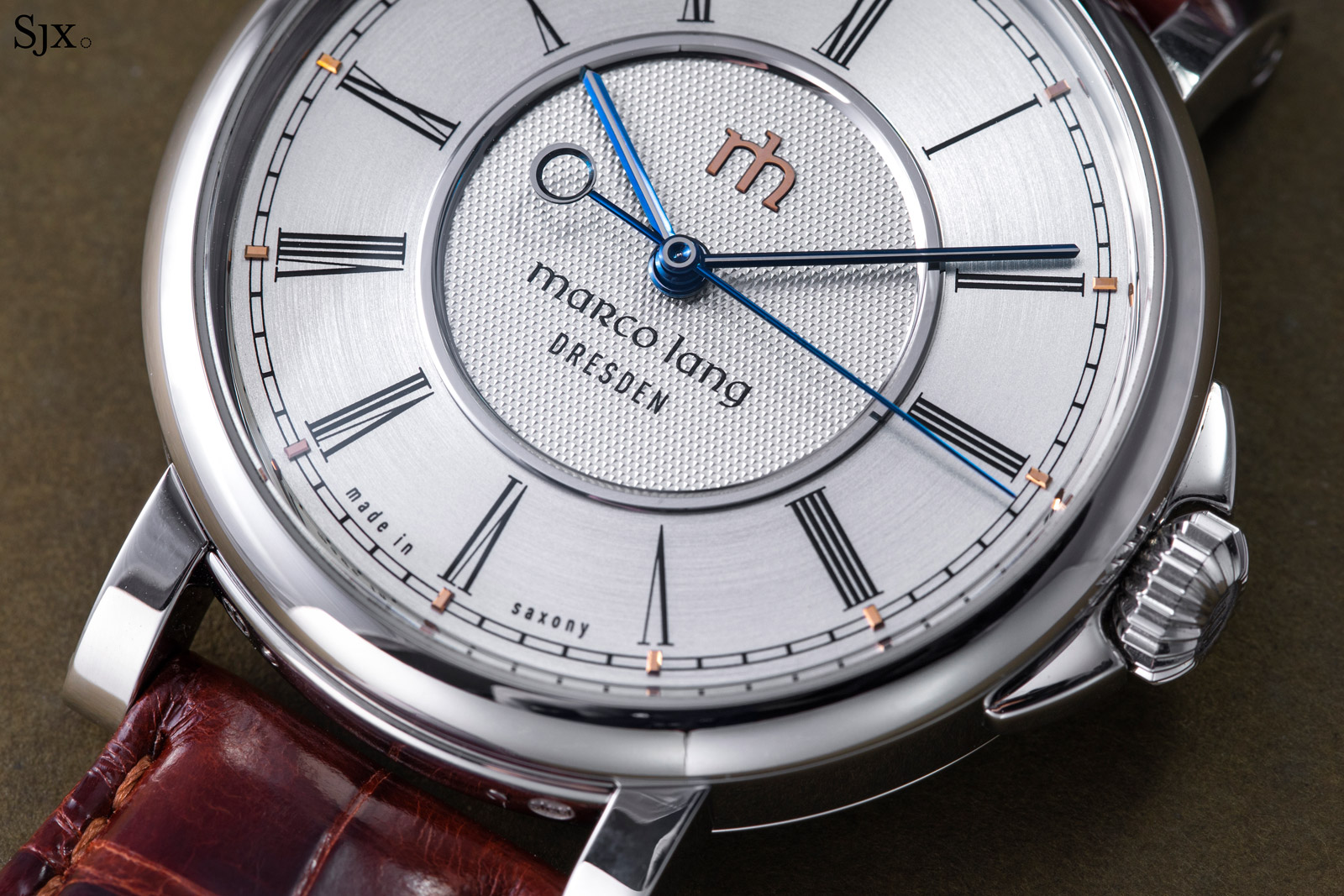
The front of the Zweigesicht is classical and mostly appealing, except for the logos that are too large. As expected, the execution is high quality despite the simplicity, most notably with the hand-made hands.
Over on the back is where the action is. This is basically the movement, but with additional gearing for the second time display that allows the watch to be worn on both sides. The movement is defined by depth, symmetry, and outstanding finishing. While some of the stylistic choices here are not to my taste, like the blued borders of the bridges, the quality of work is high.
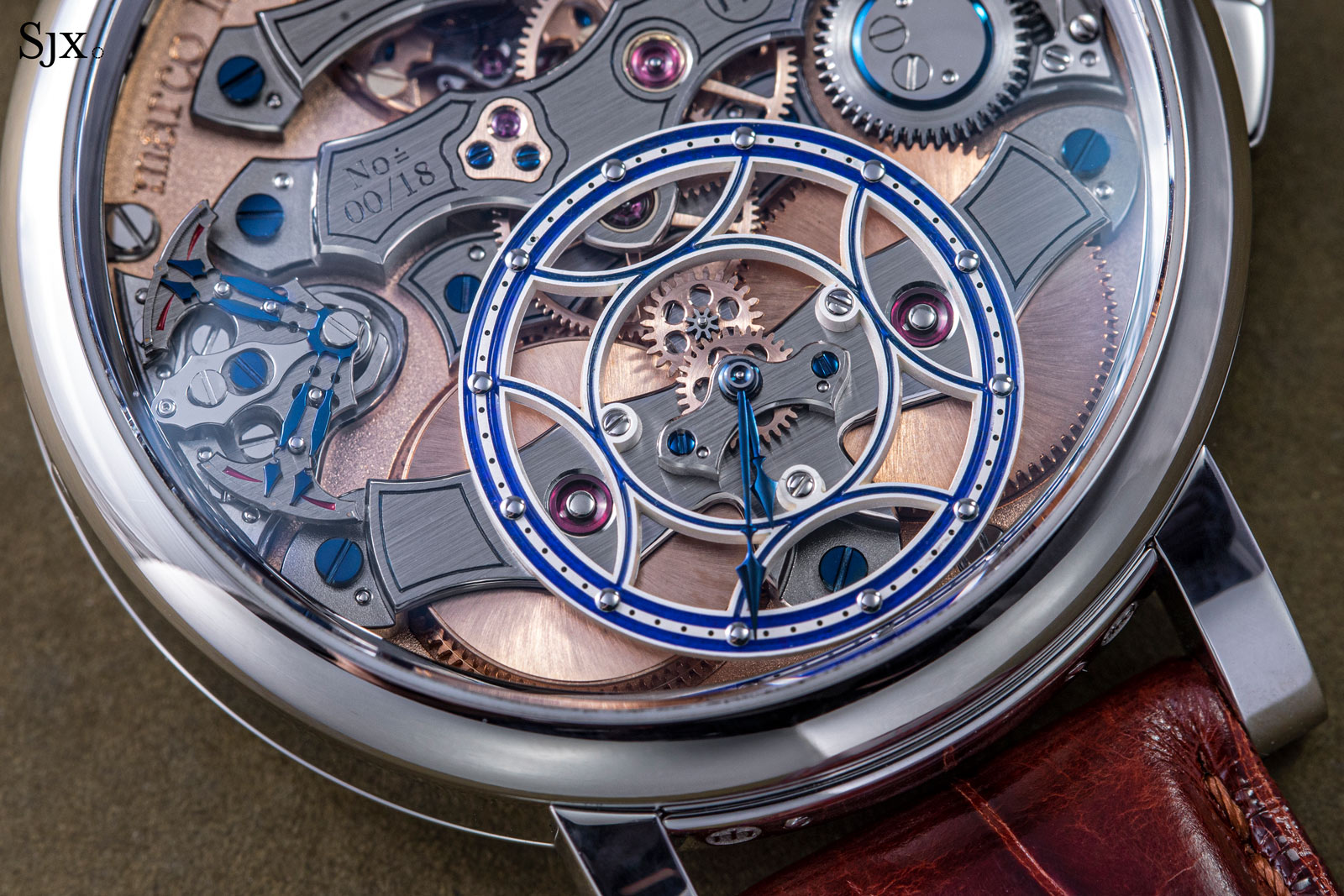
A curious feature of the movement is the shock indicator at nine o’clock. Invented by Mr Lang himself, it records and indicates shocks encountered by the movement. It is visually interesting and adds to the symmetry of the movement layout, but it feels a bit gimmicky. Fortunately the watch can be ordered without the shock recorder, though that omission might hurt the visual balance of the calibre.
More broadly, the Zweigesicht feels like a creation from a genuine independent watchmaker. I would change a couple of things about the design and still find the shock indicator a bit gimmicky, but the watch is a compelling package because it feels authentic. Mr Lang conceived the Zweigesicht and its shock indicator, fabricated many of the key components, did the movement decoration, and put everything together. The watch is him.
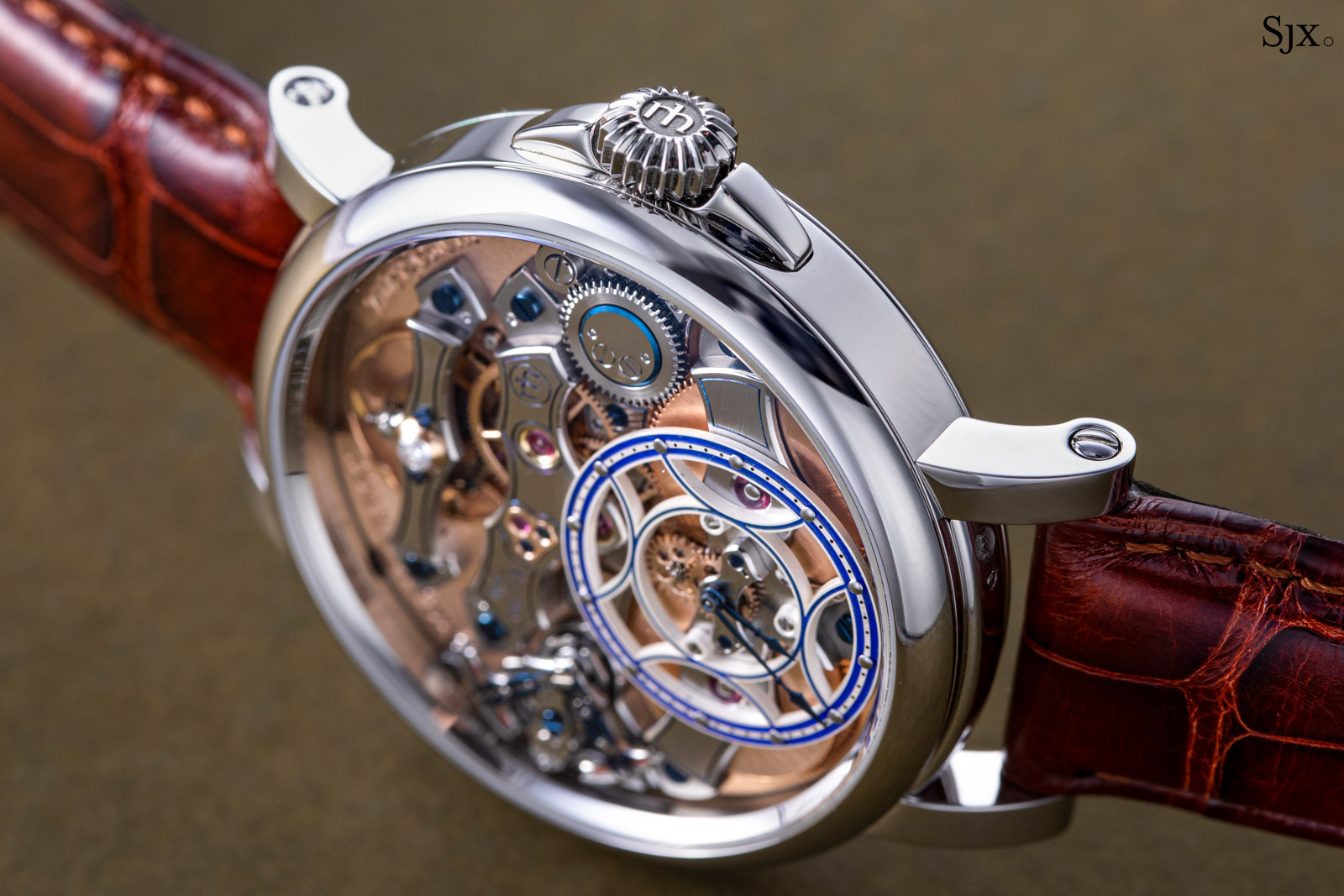
Such coherent authenticity is increasingly hard to find in independent watchmaking, simply because demand for “independent watchmaking” is high, which makes it easy to sell watches that are positioned as such.
Compare the Marco Lang brand to Moritz Grossmann for instance. Both are located in the same area and both do high quality work; Mr Lang’s finishing is superior and more artisanal but Moritz Grossmann does an admirable job. Grossmann, however, is an enterprise that was established by savvy investors who got off the ground with grants and subsidies from the local government and European union thanks to funds earmarked for developing the former East Germany. So even though the watches are of good quality, the brand feels hollow.
The authenticity of Mr Lang’s brand and product is rare and appealing in itself. Add to that the intrinsic features of the Zweigesicht and you have a compelling watch.
Two faces, one watchmaker
Double-faced watches that can be worn on either side make sense in theory, but are constrained in terms of practicality and case construction. Either they are intuitive and rectangular like the Jaeger-LeCoultre Reverso, or round and equipped with unusual lugs like the Patek Philippe Grandmaster Chime (and usually complicated to reverse). This is simply a matter of case geometry.
There has to be a tradeoff somewhere. In the case of the Zweigesicht, that tradeoff emphasises aesthetics at the expense of reversibility because Mr Lang wanted a watch that looked entirely classical in both design and size. So he devised a solution that preserves the conventional aesthetics of the case, but requires removing the lugs by loosening four captive screws on the back of the lugs.
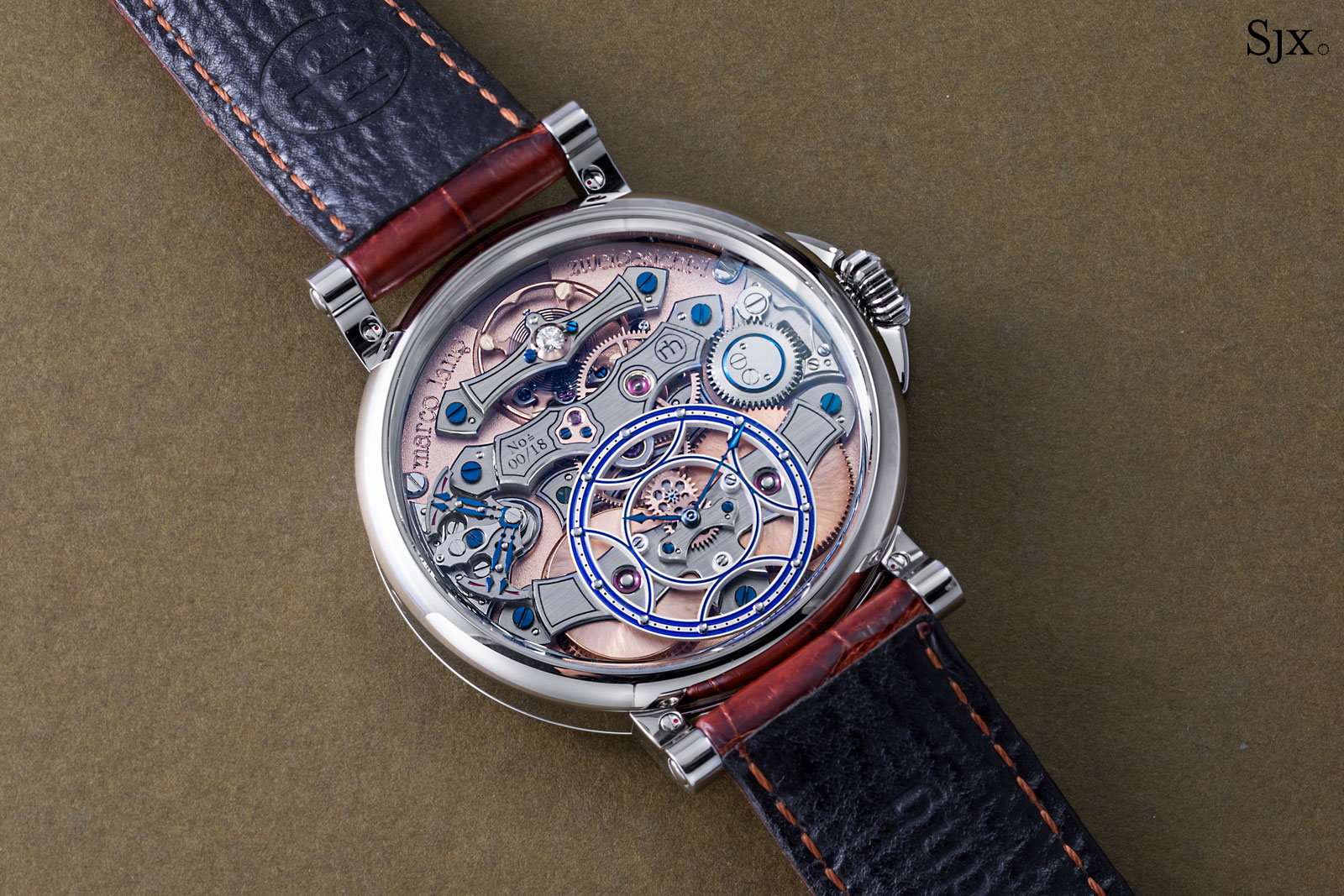
The movement is a large, 34 mm in diameter, making it a perfect fit for the 40 mm case
Each pair of lugs is a U-shaped frame that’s secured by screws to fixed pillars within the case middle. And each screw has a single red dot on its head to indicate its orientation. So reversing the case is easy on paper: loosen each screw so that the red dots point outwards and the lugs slide out. Flip the case and reattach the lugs, ensuring that screws are tightened such that the red dots point inwards.
But because the screws are small and sit in recesses in each lug, the operation is a delicate one. A slip of the hand will either scratch the lug or damage the screw slot. Mr Lang says the lugs can be reversed by the owner, but having a watchmaker do it is ideal.
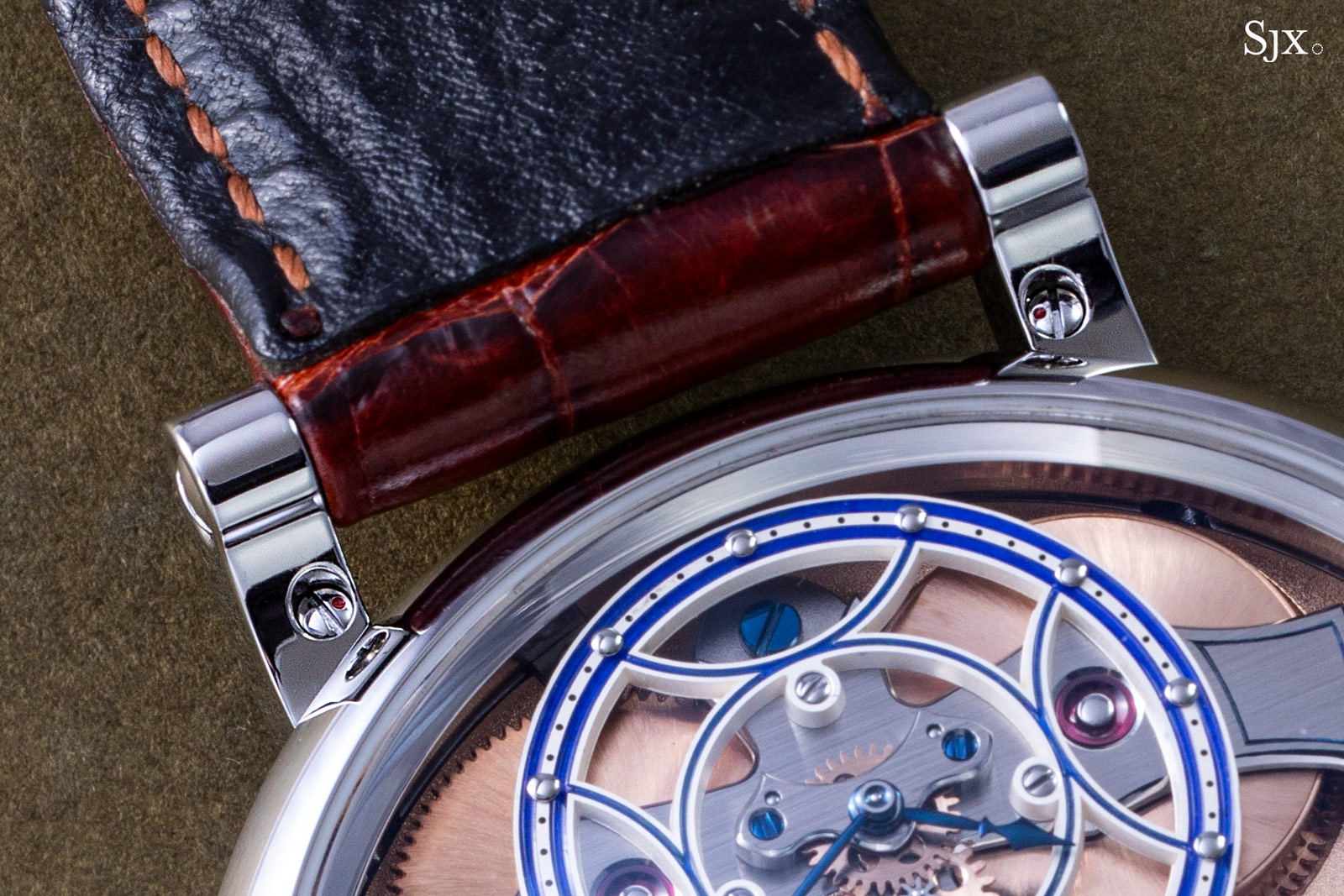
The lug screws in the locked position with the red dot pointing inwards
Notwithstanding the novelty of the removable lugs, the case is otherwise entirely classical. The case is just 40 mm in diameter and 9.5 mm high, giving it proportions that well suited to this type of watch.
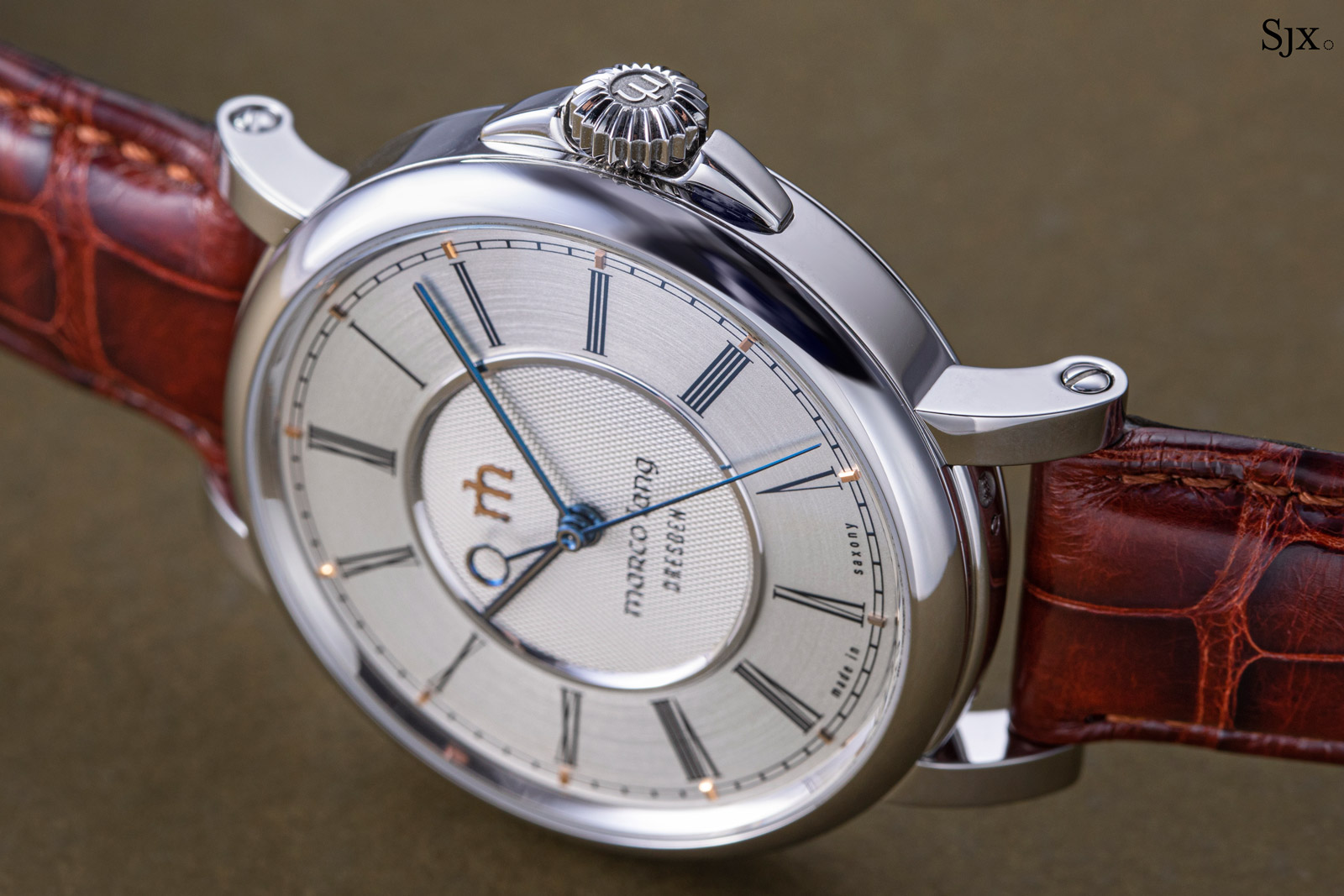
Mr Lang gets the case from a supplier but the quality is high enough that the lugs fit seamlessly into the case with no visible joint
The front dial is what one would expect from Mr Lang given his past work. A guilloche centre is encircled by a brushed chapter ring bearing Roman numerals, creating a mostly classical appearance. However, the logo and branding on the guilloche are clearly modern and look out of place relative to the rest of the dial.

While the aesthetics are good enough, the quality of the dial is excellent. Its details contribute to the refined appearance of the dial.
Naturally the hands are hand made and substantial, despite being slender. They are facetted, partially blued, and mirror polished, giving them a subtle two-tone finish. Other notable details include the applied five-minute markers and raised border around the guilloche add depth to the dial, all sporting a mirror-polished finish.

The guilloche is finely engraved
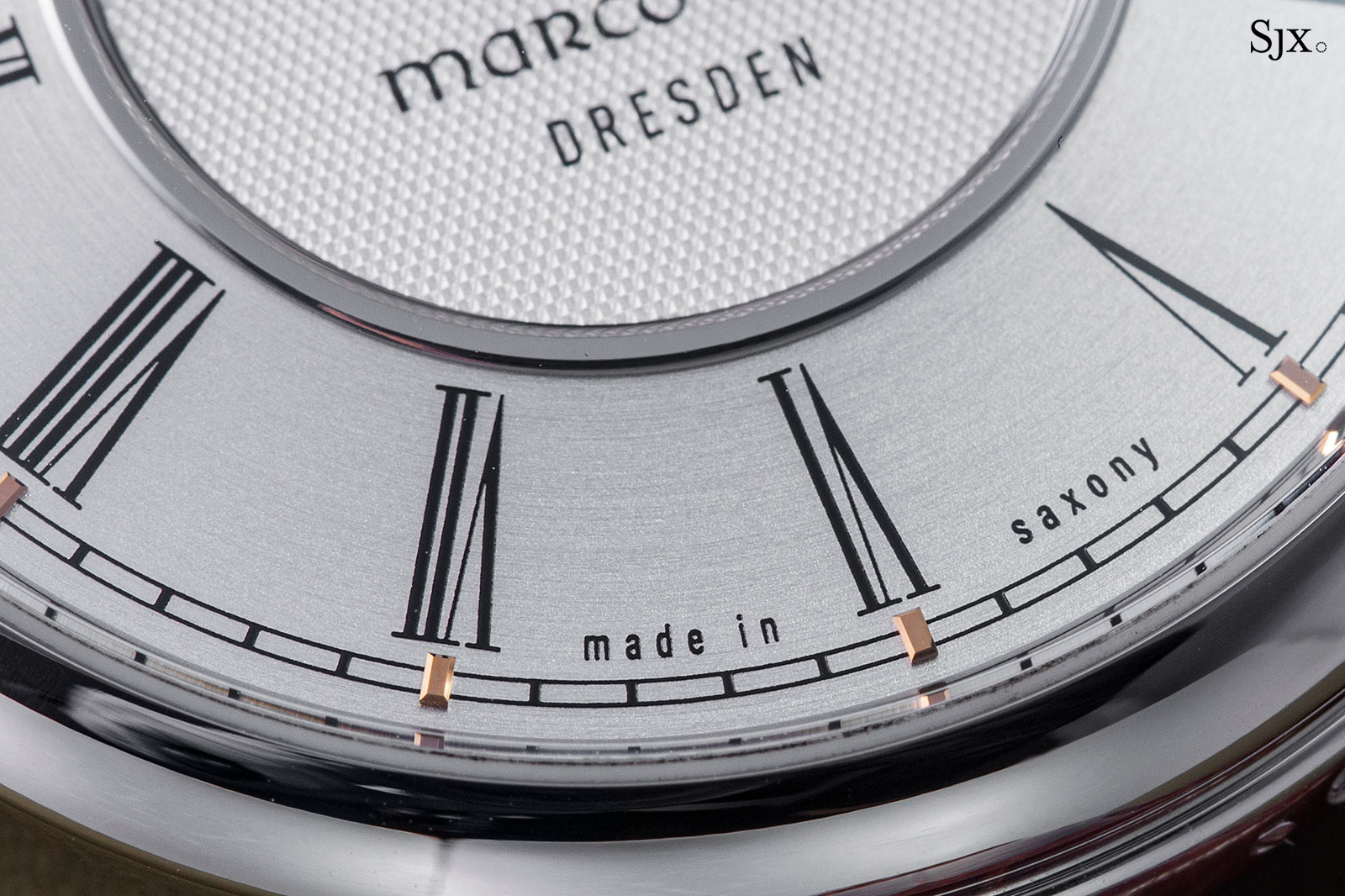
The conservative styling on the front is perhaps a logical choice in order to create contrast with the back. Turn the watch over and the view is drastically different. It is mechanical, intricate, and lavishly decorated. In terms of design, the movement is unique in blending elements drawn from 19th century pocket watches with a modern layout, which encapsulates Mr Lang’s approach to movement development.
Fundamentally, the movement is mechanically straightforward, but it has been constructed to show off lots of mechanical and decorative detail. The movement layout is symmetrical and flows upwards: the twin barrels sit at five and seven o’clock, followed by the gear trains, and then the balance wheel at 12. Each key section of the movement – balance, going train, barrels – is secured by a lateral steel bridge with heat-blued borders.
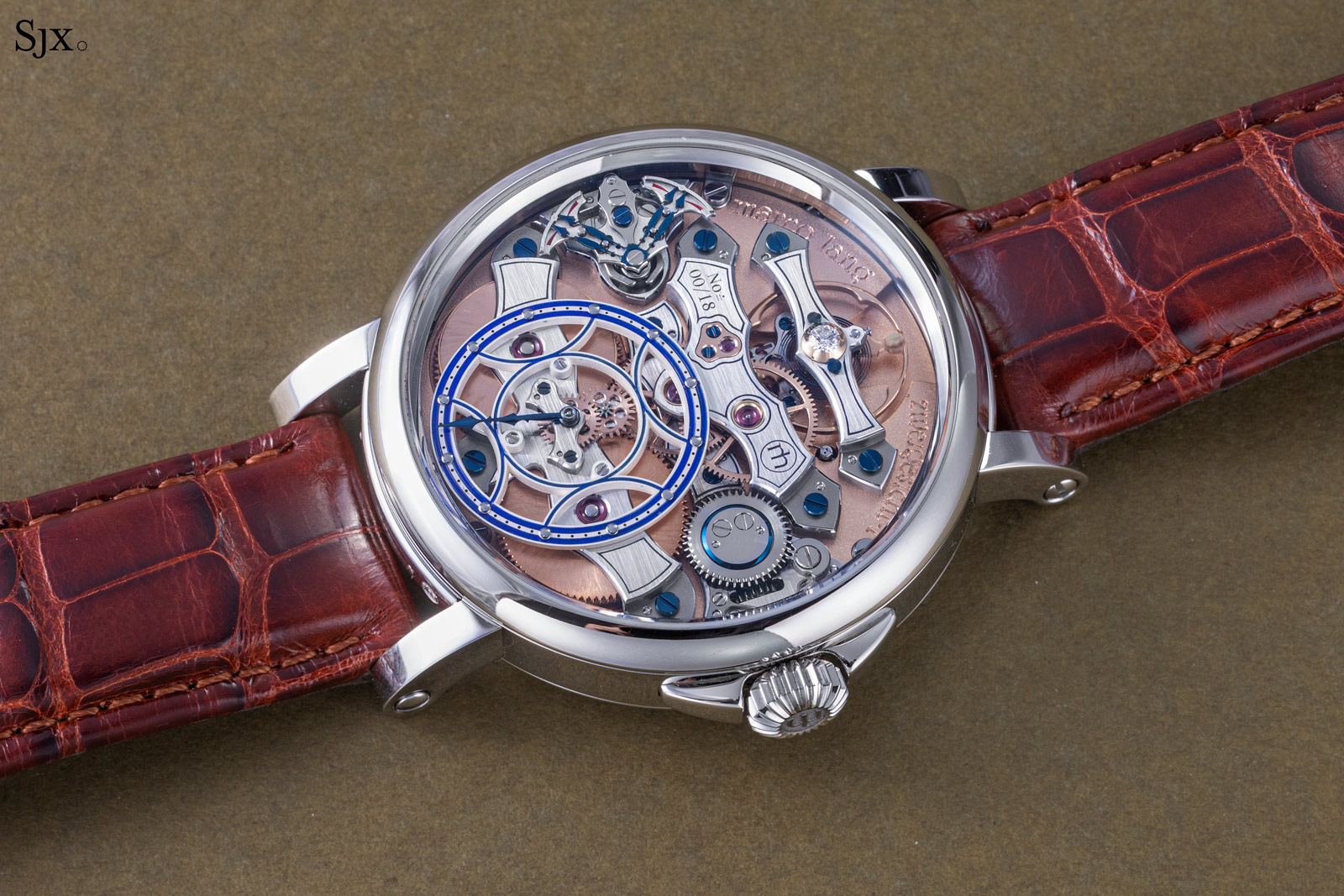
Because the watch has two time displays, it also has two gear grains. The primary gear train, comprised of larger gears, drives the hands on the front. A secondary train with smaller gears drives the hands on the back. Interestingly, this secondary train travels backwards towards the barrels, so the time display is located on the barrel bridge.
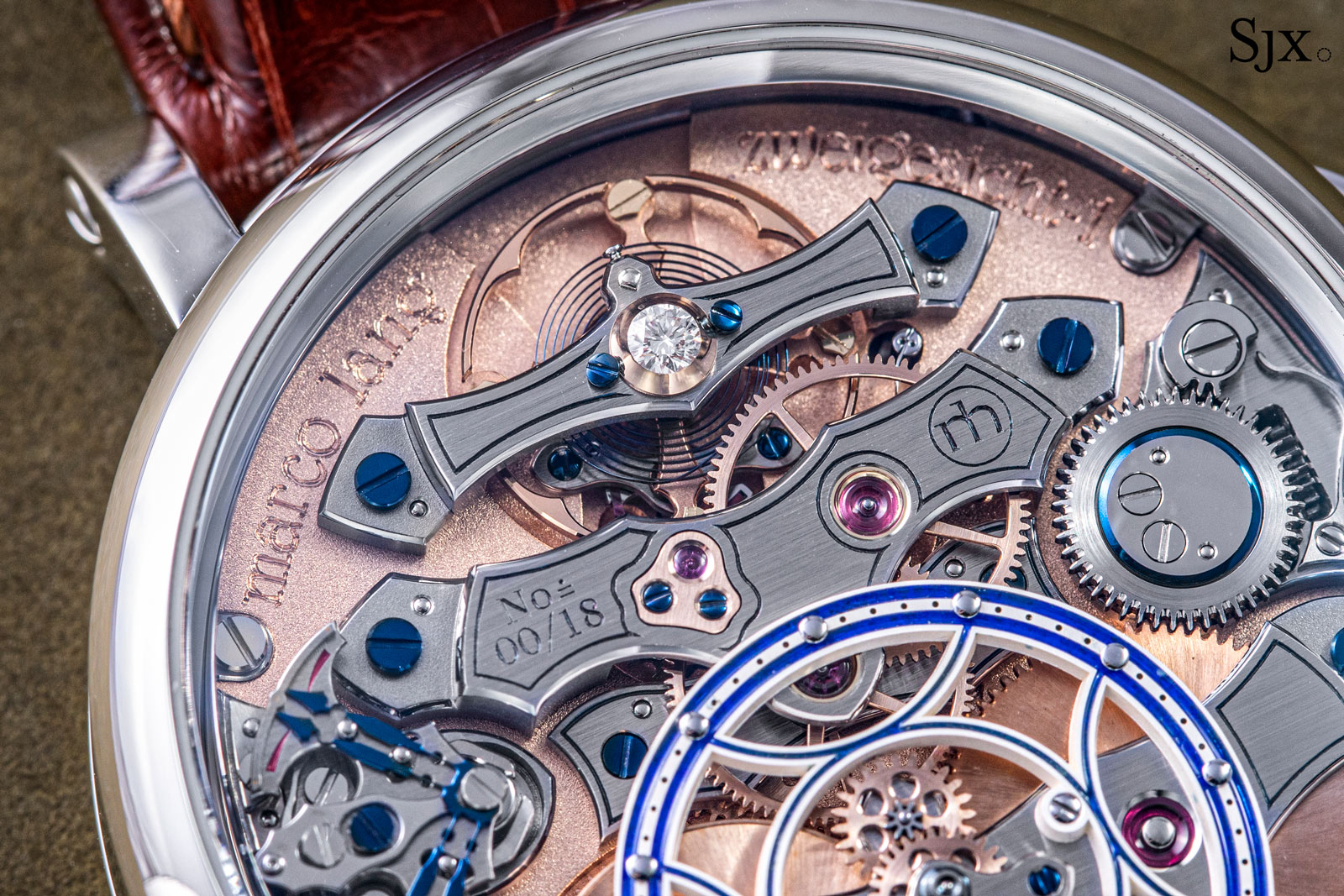
The time display is made up of extremely fine, blued steel “cathedral” hands that point to an open-worked dial in a Gothic pattern inspired by church windows. The dial ring is actually solid silver and filled with fired blue enamel. Although the time display is made up of an odd mix of elements, ranging from the old-school hands to the wing-shaped barrel bridge, it comes together in a cohesive manner.
Because of its position, the barrel bridge forms a platform for the open dial that focuses the attention on the time. Admittedly, legibility is not ideal given the intricate appearance of the reverse face, but it is beautiful.

The same is true for the rest of the movement. Even though the calibre includes some decorative details I do not like, the blue borders on the bridges for example, the overall aesthetic works well.
Perhaps the best characteristic of the movement is the deft blend of old and new in terms of design and decoration. The frosted gilt base plate, gold chatons, raised blued steel screws, and even a diamond endstone are straight out of 19th century pocket watches, but the brushed steel bridges and shock indicator are definitely 21st century.
Shock recording
While the movement is already intriguing thanks to the double-sided display, its novel complication is the shock indicator at nine o’clock.
The mechanism consists of a weight and four spring gauges that correspond to the four directions (along the X and Y axes on the same plane as the movement). Each of the gauges records the shock received by the movement in the respective directions, displaying the result with blued steel arrows. The shock recording can then be reset via a corrector on the case flank.
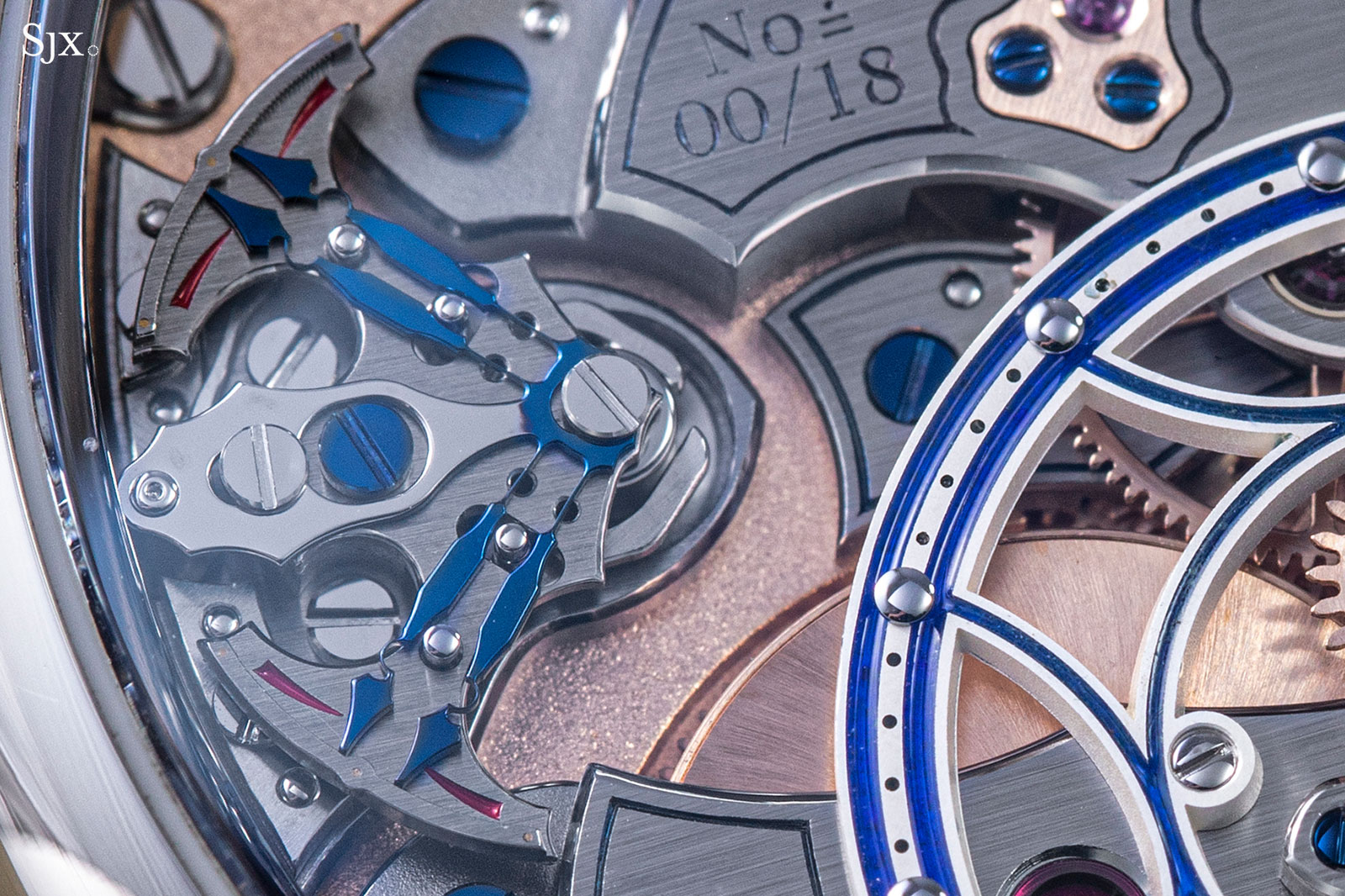
The mechanism is contained within a module that measures barely a 10 mm across and works independently of the base movement. In other words, the module can be installed in any movement that has the space to accommodate it. The modular approach also means that the shock indicator is optional – the Zweigesicht can be ordered without the shock indicator, leaving an engraved plate in its place.
Despite seeming complex, the shock indicator is surprisingly simple mechanically, but constructed to be compact and cleverly integrated into the movement, particularly in how it enhances the movement’s symmetry.
The heart of the shock indicator is a cylindrical ruby that functions as a freely-moving weight that slides around in the direction of a shock. It is held in place by two flexible steel forks that are arranged perpendicular to each other along the X and Y axes of the movement plane.
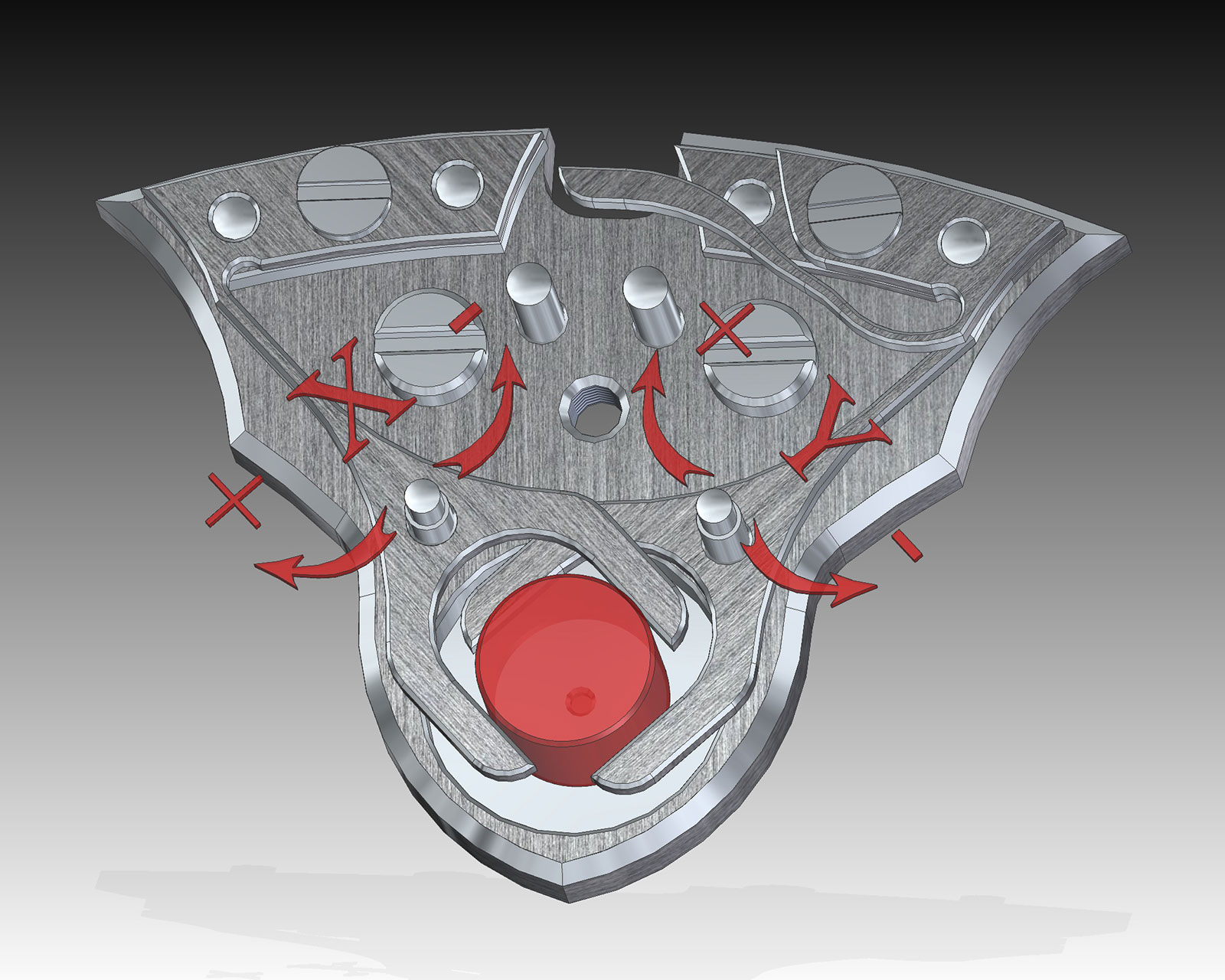
The ruby weight with its two forks. Image – Marco Lang
The stiffness of the steel forks are crucial as they serve two purposes. First, they need to be strong enough to return the ruby cylinder back to its original position after being displaced by a shock. Second and more importantly, they need to be finely tuned to a particular stiffness in order to measure the distance travelled by the weight due to a shock.
Too much stiffness and the forks can only measure strong impacts that may already exceed the threshold that would damage the more delicate components of the movement. Conversely, forks that are too pliable would bend too much at the slightest shock, which doesn’t allow any useful measurement of the magnitude of the shock, and instead only indicate its direction.
Four blued steel hands are employed to record and display the direction of shocks. The hands sit on a bridge right above the ruby cylinder and steel forks. At rest with no shock detected, the hands are centred in the middle position.
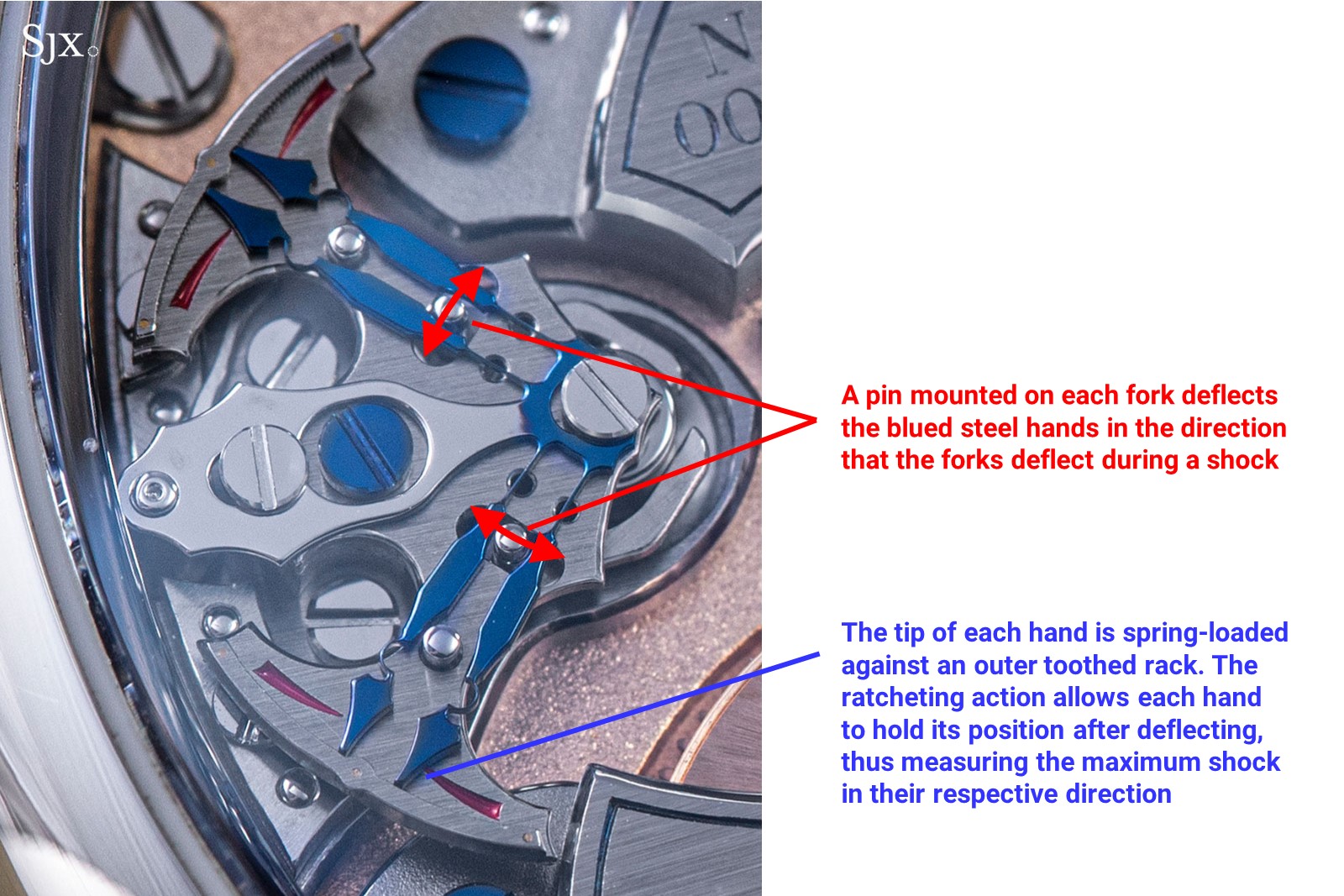
Each fork below has a protruding pin that interacts with the respective pair of hands. In the event of a shock, the pins deflect the blued hands outwards in the direction of the shock.
Finally, a toothed rack on the bridge keeps the tips of the hands in position after they have been moved by the pins. This ratcheting system allows each hand stay in position after being deflected, allowing the hands to register the maximum shock in each direction.
A pusher recessed into the case flank easily resets the shock indicator. Like the corrector for a calendar, the pusher has to be operated by a stylus. Depressing the pusher releases the ratcheting mechanism by unhooking the tips of the hands from the toothed racks, returning the hands to their neutral position.

Decoration
Given Mr Lang’s reputation, it is a given that the decoration of the Zweigesicht is excellent. Examined up close, the movement lives up to expectations.
A gilt, frosted base plate serves as the background for the components, all of which hare carefully and thoroughly decorated. Every edge is chamfered and every surface is finished, right down to the chamfered screw heads and polished pins. Even the wheels are made of 14k solid rose gold.

Some of the outstanding details include the bevelled edges on the balance wheel and the two-tone crown wheel that is black polished steel but enhanced with a flame-blued ring.
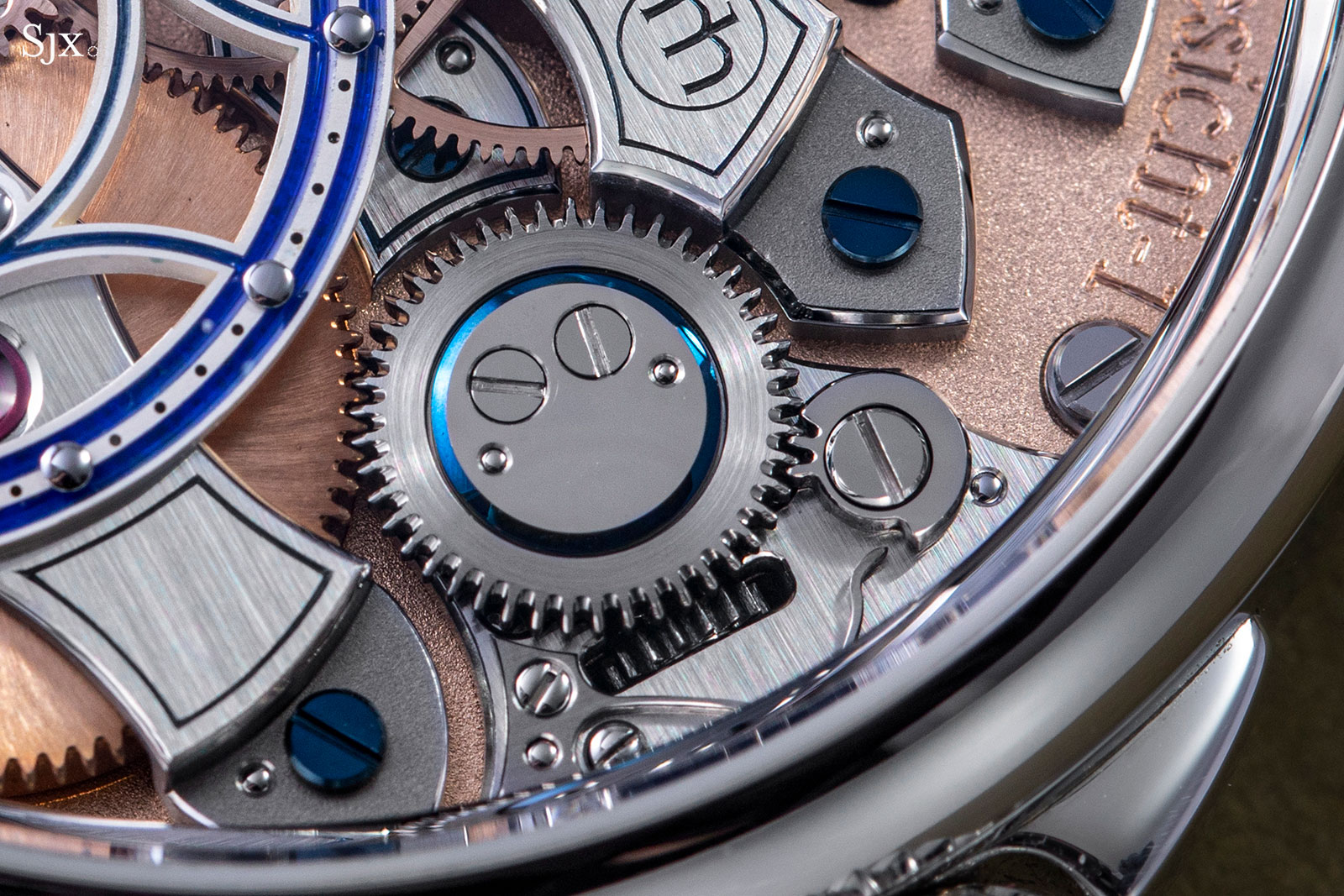
Also noteworthy are the hardened steel bridges that are straight grained on top but frosted on their bases, creating a contrast that increases the visual depth of the bridges.
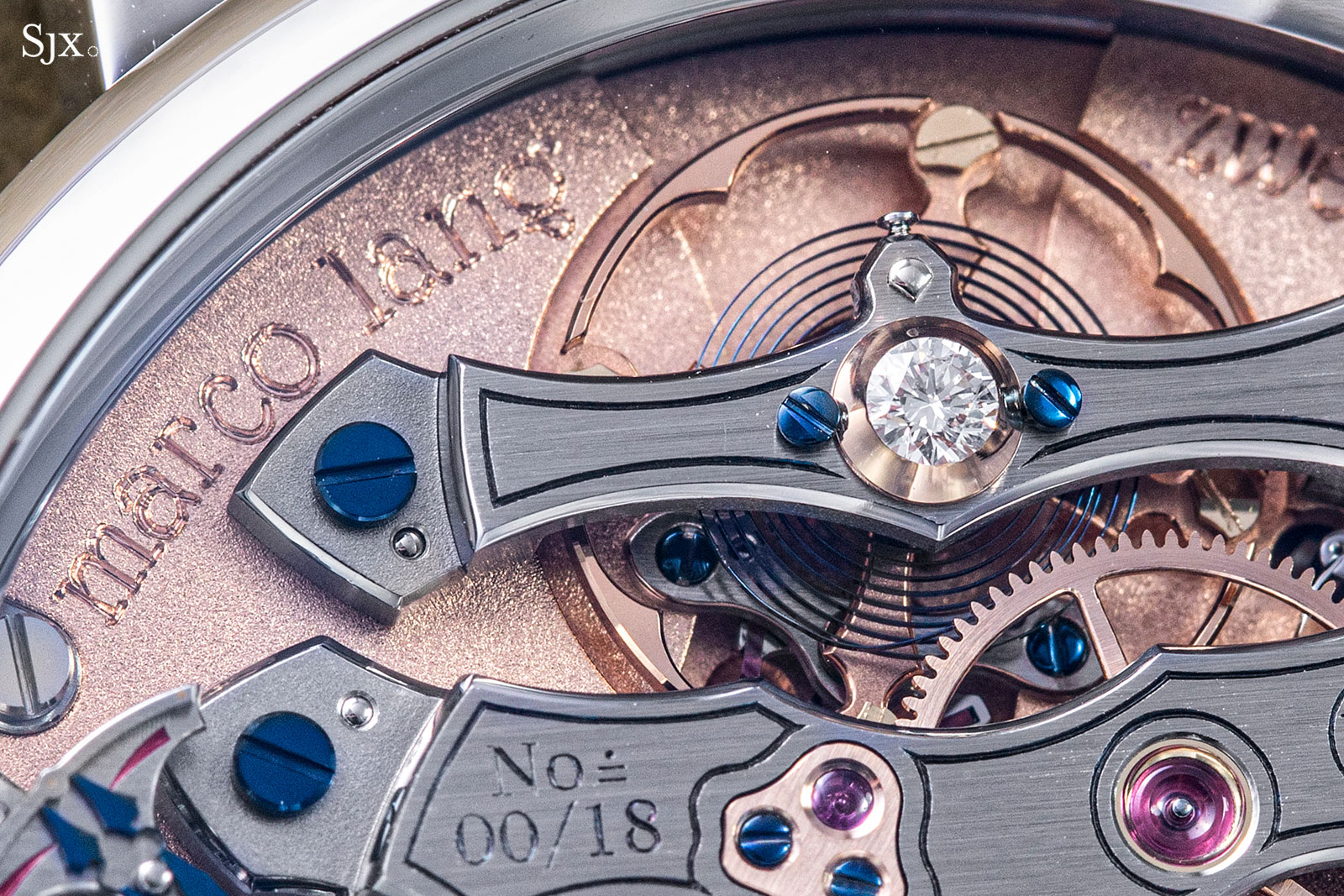
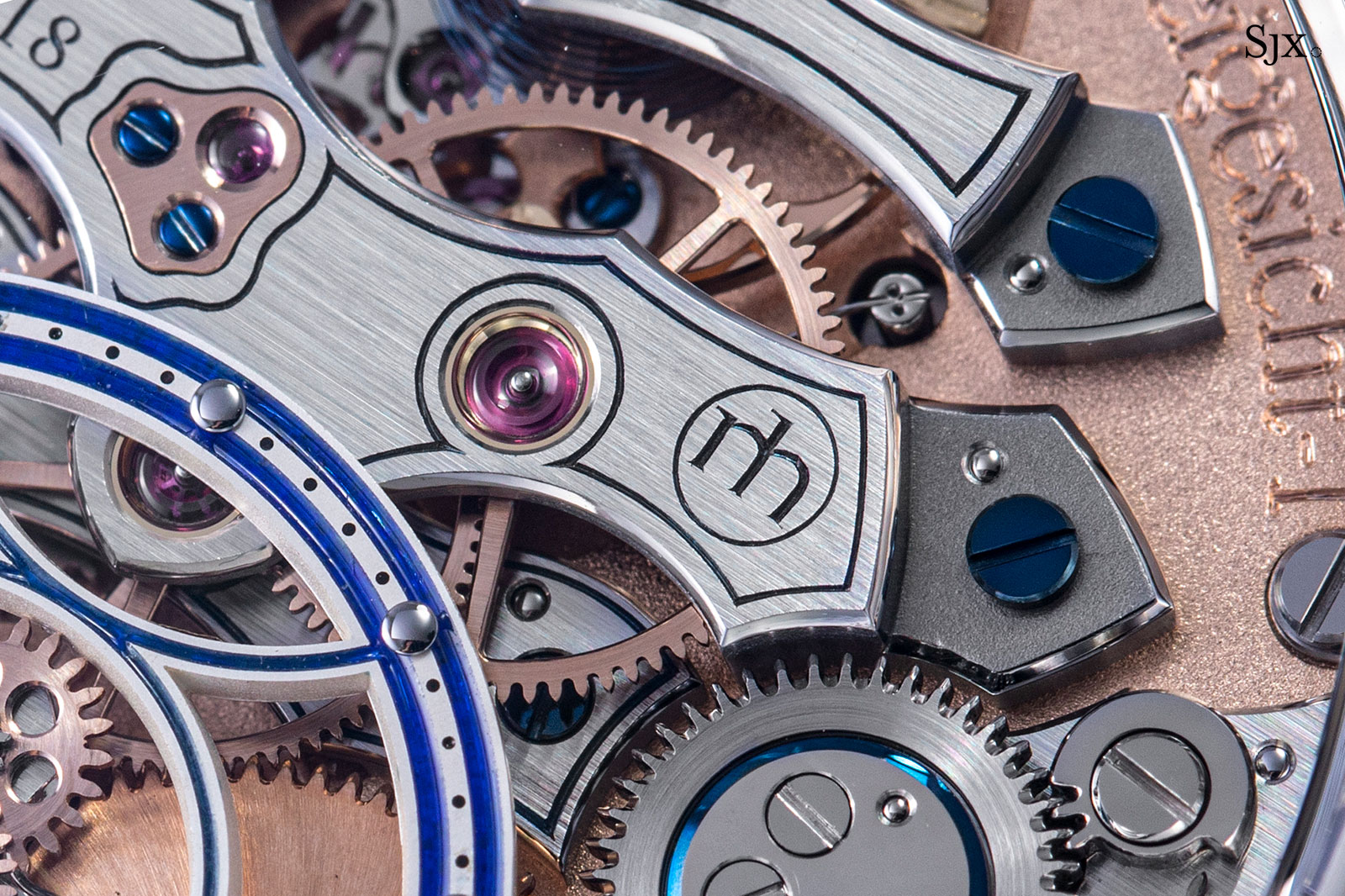
As an aside, some might point out that the bevelled edges lack sharp inward angles. Given that such angles are now often created by machine and then given a once over by hand, I don’t see that as a shortcoming. In fact, I prefer Mr Lang’s decoration, which for sure is done by hand, over something that merely appears fancier.
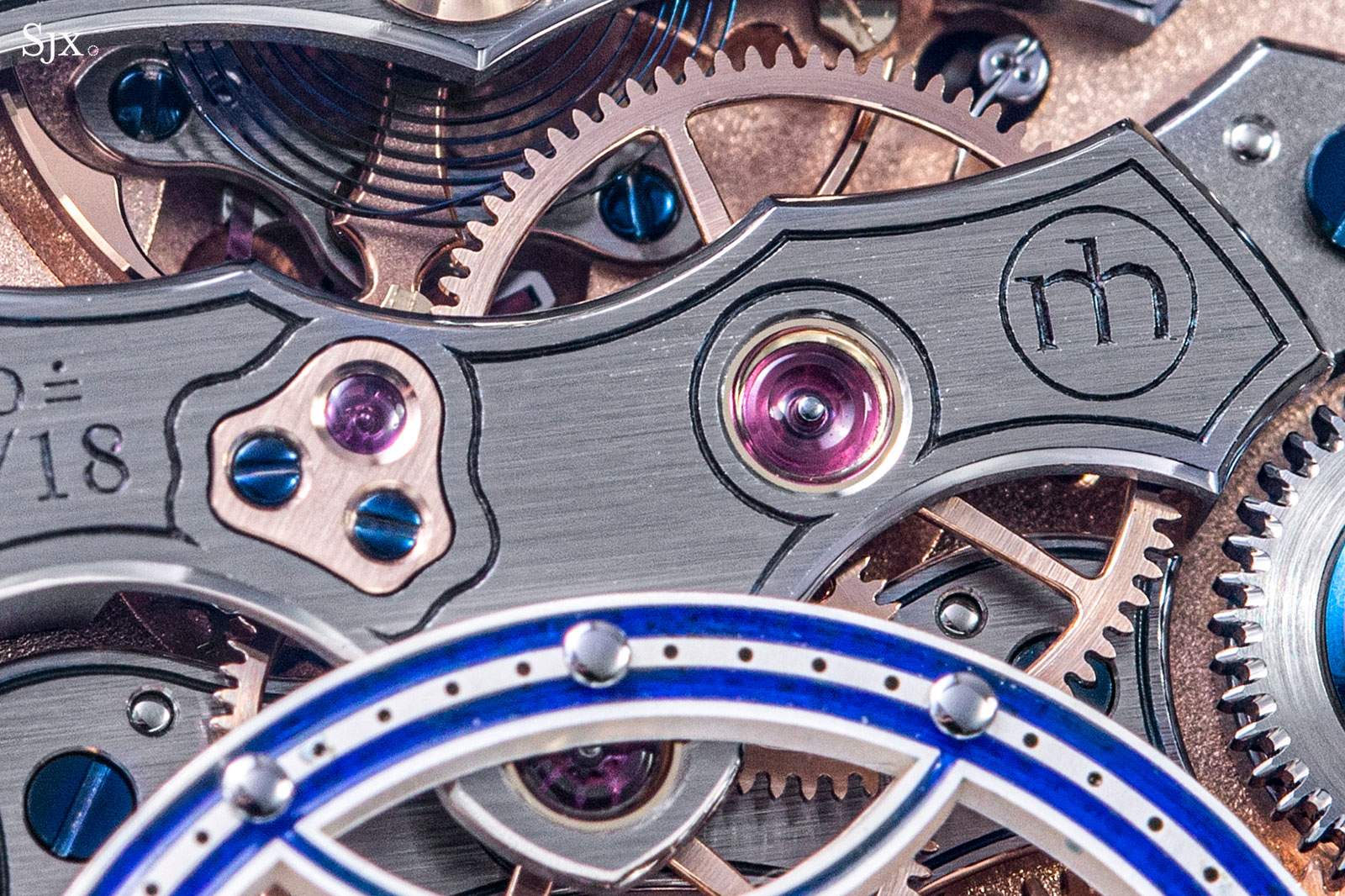
Concluding thoughts
The key qualities of the Zweigesicht – it is quirky, technically interesting, and finely decorated – reflect Mr Lang and his approach to watchmaking. His personality manifests in the watch because the brand is essentially a one-man show.
The man and the brand are one and the same, with Mr Lang himself doing much of the manufacturing, decoration, and assembly. As a result, the also possesses a crucial characteristic, but one that is increasingly rare in independent watchmaking, authenticity.
Even though some of its details are not to my taste, the sum of the whole is greater than the parts. The Zweigesicht is an original, compelling watch.
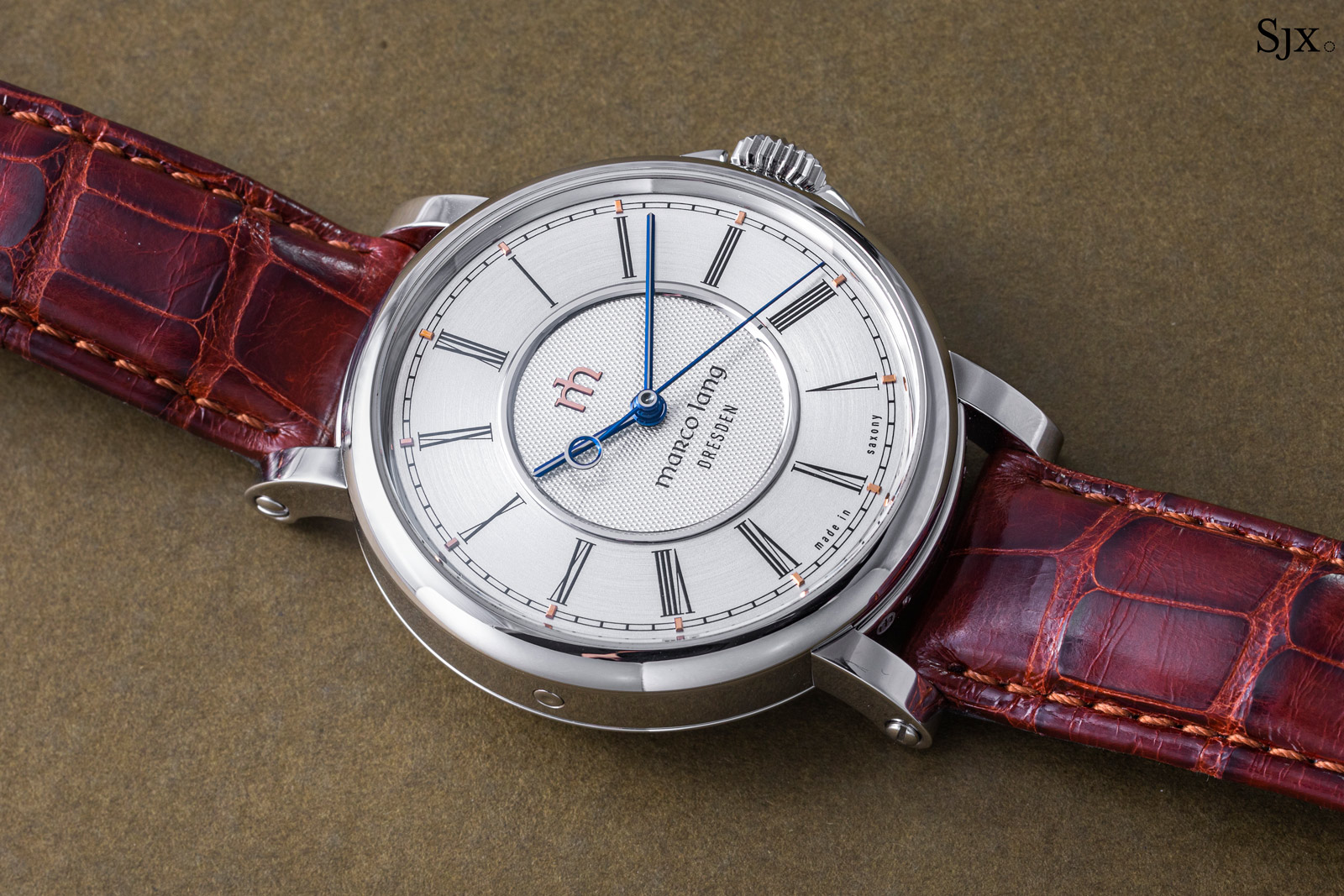
Key Facts and Price
Marco Lang Zweigesicht-1
Diameter: 40 mm
Height: 9.5 mm (without sapphire crystal)
Material: Steel, 18k rose gold, or platinum
Crystal: Sapphire
Water resistance: 50 m
Movement: Caliber ml-01
Features: Hours, minutes, seconds, shock indicator, and double-faced time indication
Frequency: 21,600 beats per hour (3 Hz)
Winding: Hand wind
Power reserve: 70 hours
Strap: Alligator with shark lining
Limited edition: 18 watches
Availability: Sold out
Price:
With shock indicator – steel €57,000; rose gold €65,000; and platinum €68,000
Without shock indicator – steel €51,500; rose gold €59,500; and platinum €62,500
Prices exclude taxes
For more, visit Marcolangwatches.com.
Correction August 22, 2023: The borders of the bridges are heat blued and not lacquered as stated in an earlier version of the article.
Back to top.
